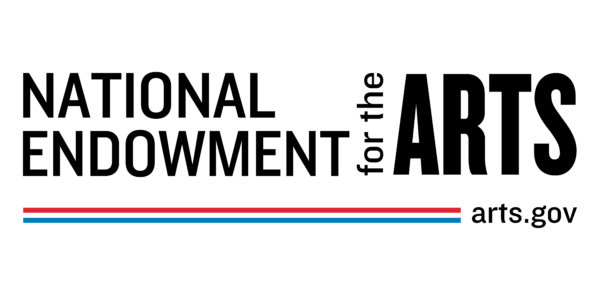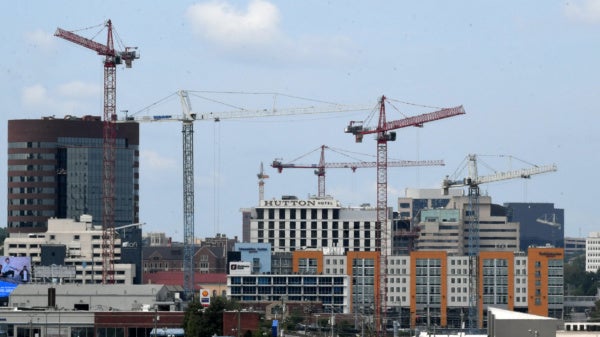
It’s Saturday morning at C.E. McGruder Family Resource Center in North Nashville, and people file in to a waiting area where artists have set up stations. There are index cards and poster boards and markers, maps and Post-its. But the people have come from around Nashville for the food pantry downstairs – not the art. Most Saturday mornings, folks are herded into the center’s library and given a number. Some chat, some doze off, some play games on their phones or make calls to relatives.
The artists are part of McGruder Creative University (M-CRU), a program of McGruder Social Practice Artist Residency that Courtney Adair Johnson and Marlos E’van run from the center. In its inaugural semester, M-CRU held four multi-day workshops that were free to the community. Today’s is the final workshop.
The people who have come for the food pantry are reluctant to join the artists at first, but they slowly engage. At one table, Kazadi Kazadi asks people about the history of their names and transcribes their answers. At another, Marguerite Zabriskie and Rita McClain have a sign and index cards: “What would you title the story of your life?” At another station, E’van asks people to record in a handmade book what they’d like to see in their community and what they miss that’s already gone. Out in the hallway, Johnson and Jana Harper ask people to draw their daily route on a big map of Nashville and to talk about whether they see themselves as nomads or farmers. Trevor Sarter has set up a chess board and waits to see who approaches. As the morning goes on, about 100 people encounter M-CRU through the food pantry and other services offered by the center. “I need community to work with,” Johnson says. “I can’t be silo-ed.”
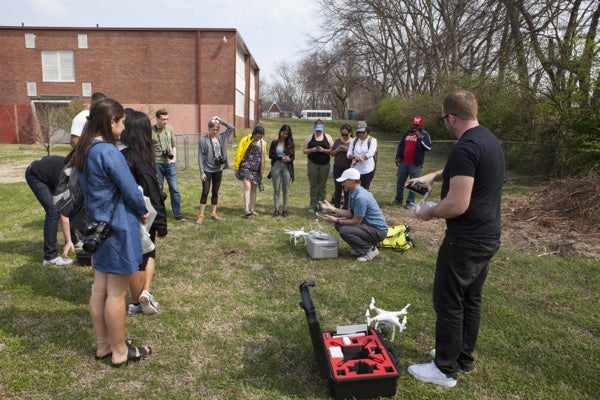
To get the residency off the ground, Johnson received an award from Metro Arts Commission, the city organization that programs and funds everything from big public art projects to neighborhood murals. [Full disclosure, the author has a writing residency at M-SPAR for which she is not paid.] Johnson is skilled at grant seeking and fostering collaboration among peers. M-CRU partners with Fisk University, Tennessee State University, and Vanderbilt University. Past workshops have brought in artists to collect and archive sounds, photographs, and stories about the neighborhood with members of the community. In one, Vesna Pavlović and Seattle-based artist Tivon Rice photographed North Nashville with flying drones and then used a process known as photogrammetry to make 3-D portraits of the landscape. The processing makes it look flattened and like it’s slowly being erased. In another, Tugaloo University professor Phoenix Savage and participants collected sounds from the neighborhood and then interpreted them visually.
But even the phrase “brought in artists” can imply that artists are cultural emissaries who can solve another community’s problems with a stroke of a paintbrush, which is why Johnson and the artists who participate in M-SPAR are careful not to impose an outside perspective on the people the center serves.
Johnson, a reuse and social practice artist, moved to North Nashville two years ago from elsewhere in the city. When she heard that McGruder Family Resource Center’s board was looking to broaden the center’s reach, she made a connection. “I’m always working with under-utilized resources and materials that no one wants, trying to highlight the potential there,” says Johnson. She saw the center as a place to have a studio – some of its second-floor rooms and an entire wing were unoccupied – while trying to solve this specific problem the center faced.
North Nashville is a historically black area. It hosts four HBCUs, all of which were instrumental during the Civil Rights Movement. It was students from American Baptist, Fisk University, Tennessee A&I College (now Tennessee State University), and Meharry Medical College who organized the early lunch counter sit-ins of 1960. The students successfully desegregated the lunch counters, and some, such as Congressman John Lewis, Diane Nash, James Bevel, and Bernard Lafayette, participated in the Freedom Rides and went on to leadership positions in SNCC and the SCLC.
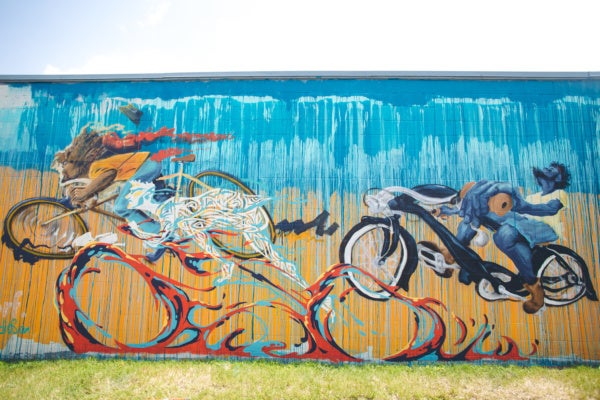
The neighborhood is steeped in history that cannot be divorced from its African American culture and traditions. Doughjoe is an artist-in-residence at M-SPAR and co-founder of Norf Art Collective, a multidisciplinary creative team that both addresses social issues in North Nashville and celebrates the community’s assets. Those social issues are far-reaching and include food deserts, health, and youth development.
It’s easy for reporters to try to eke out a single story about the neighborhood. Lately, the hot issue has been gentrification. Doughjoe says he prefers to focus on addressing the immediate needs of his community, so he’s hesitant to discuss the encroaching gentrification of North Nashville. But once he starts, he has a lot to say, particularly about the role of artists in a changing city.
“They are the creators of this movement of people, whether it’s moving people in a positive manner, bringing them together to make them stronger as a whole, or attracting new people to the area.” That last part, attracting new people to the area, is fraught with foreboding.
Arting the It City
If you’ve been to Nashville lately, you may have noticed that the skyline is dotted with construction cranes that jut from city’s center. Some say it looks like progress, but for longtime residents, it’s an almost universally reviled image. The once-small city, many residents recall, used to feel more like a small town.
When the New York Times called Nashville the next “It City” in early 2013, diehards thought it was the beginning of the end. “The instant you start to take stock of a moment …you kill it,” Nashville Scene declared. “You’ve already started processing it and filing it away, which means you’ve effectively stopped living it.”
But the moment continues for some, albeit with more branding. The U.S. Census shows that in 2015-16, the metro area continued its growth of 100 people per day, and there’s no sign of slowing. With increasing tax incentives from the city, developers and hoteliers are still having a field day. Such rapid development raises issues––and opportunities––for artists that, if done right, can bring out the vitality of existing communities while accommodating the influx of new residents. To some, creative placemaking is a harbinger of gentrification and displacement. For others, it means opportunity and socially conscious growth. But for many, the meaning of the word is hazy, so let’s get that out of the way first.
Creative Placemaking 101
Though creative placemaking was first coined in a 2010 white paper by Ann Markusen and Anne Gadwa for the NEA, placemaking has been around far longer. It’s a branch of the philosophies about public space of people like Jane Jacobs and William H. Whyte––that logic can’t be superimposed on a city but must rather grow organically from the behavior and dynamics of its people.
On paper, the intentions of placemaking are exciting: it aspires to a bottom-up approach to developing public space in a way that is attentive to cultural and social identities. Creative placemaking, therefore, places artists at the fore; artists are already creative problem solvers, and some may approach social problems in civic life productively. While this may be true, artists are usually not social workers. Most are not trained in community organizing. And many have only a passing knowledge of identity politics that are inextricably linked to how cities invest in neighborhoods.
Jyoti Gupta is a doctoral student in the department of Health and Organizational Development at Vanderbilt and part of the department’s Community Research Action Program. She researches how efforts to shape cities promote social inclusion or marginalization.
“While placemaking professes to infuse urban developments with a public, civic, community sensibility, it often reproduces exclusions, intentionally or unintentionally,” says Gupta. “[Placemaking] is commonly in places that have historically experienced a degree of divestment, have low property values, and where developers and cities are able to speculate on what the place is going to be worth in the future. Creative placemaking is often about making those places economically vibrant. Advocates of creative placemaking might emphasize that it’s not about profit but about making places more livable for those who already live there, but that’s not really consistent with how gentrification works, and a lot needs to happen to make that kind of protection a reality.”
Megan Barry is the city’s first woman mayor, and she campaigned on a platform of progressivism and inclusion. But some worry that the city’s progressive rhetoric––buzzwords like leveraging diversity, fostering equity, activating public spaces that pepper New Nashville’s vocabulary––is part of the city’s rebranding effort to erase its long history of racism and oppression. For example, although the Trail of Tears runs through the city’s center, Andrew Jackson is claimed by the Nashville Democratic Party with its annual Jackson Day celebration and fundraiser. “Old Hickory” made his fortune as a Tennessee slave owner; he owned roughly 100 human beings when he signed the Indian Removal Act in 1830. In 2015, the chairperson of the Tennessee DNC Mary Mancini called for discussions about Jackson’s legacy within the party and raised the possibility of changing the name of the annual fundraising event. Nothing came of it. At the same time, activists called for the bust of Confederate General Nathan Bedford Forrest, a brutal slave trader and first Grand Wizard of the Ku Klux Klan, to be removed from the state capitol building. Neither call for change stuck.
Is Nashville’s progressive identity all talk? Or are the city’s conservative attitudes in their death throes? The truth probably lies someplace in between. Gupta is interested in how artists are operating in public spaces and whether they’re trying to create democratic opportunities. “What does it mean to have civic interaction in artistic spaces?” asks Gupta. “Can those spaces be transformative?”
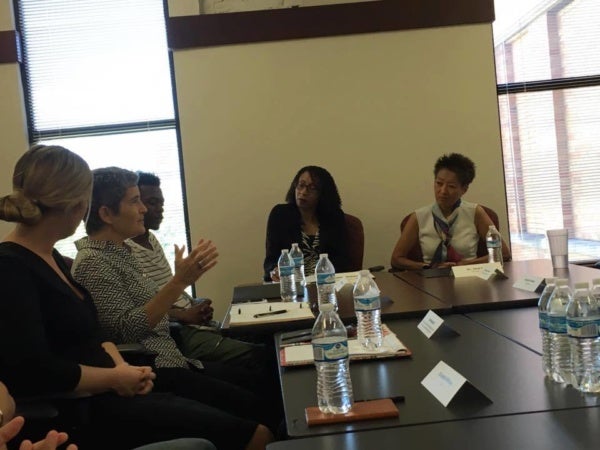
Spaces for Deep Dialogue
When Metro Arts Commission wrote its five-year strategic plan in 2015, it committed to driving equity and inclusion in the arts in Nashville. To take the temperature of the city’s arts organizations, they and Vanderbilt’s Curb Center for Art, Enterprise and Public Policy commissioned a study. Gupta interviewed representatives from 18 arts and cultural nonprofits and analyzed their responses against national trends in her white paper “Holding the Mirror Up.” Those organizations ranged from the well-endowed Nashville Ballet and Nashville Symphony to small groups such as the contemporary art lab Seed Space.
The study identified some biases in organizational thinking that are indicative of where the art field is nationwide, but there appeared a general enthusiasm for inclusion and an exasperation with its challenges. Chief among these is getting beyond the transactional relationships that can result from one-off collaborations with community members. Art makers and administrators want to create meaningful work for and with communities, but their already scant resources and staff prove to be a barrier. Some respondents identified the need for more cultural spaces in neighborhoods that have seen divestment, but they expressed concerns that renting space in these areas could accelerate cultural and domestic displacements.
Jen Cole is executive director of Metro Arts Commission. “How do we create space for deep dialogue where people can identify their own unconscious bias and then see how it fits into the work that they’re doing in their organization?” says Cole. “We can’t dictate to every nonprofit how they can think about their work, but we can create a space where that discussion can happen.”
Shortly after launching the 2015 strategic plan, Cole brought on Cecilia Olusola Tribble as community and organizational development coordinator. Tribble envisioned and built the Racial Equity in Arts Leadership (REAL) program with Gupta and Marie Campbell, who was at the time assistant director of education at Scarritt Bennet Center, a nonprofit education center in Nashville. The program invites artists and arts leaders to a sort of crash course in intersectionality that bridges the arts. Participants in the learning cadre attend lectures with visiting artists, organizers, and policy makers and engage in guided conversations as a group.
They start with an intensive weekend workshop with CrossRoads Antiracism Organizing and Training to learn a shared vocabulary of intersectionality, going over topics like white fragility, the trouble with “post-racial” politics, and cultural metaphors. They then turn to arts and cultural organizing, studying people working at the intersection of art, community, and social justice today. The heady reading list includes Thomas Jefferson’s Notes on the State of Virginia, in which he infamously compares women of African descent to orangutans; bell hooks; Audre Lorde; Michelle Alexander; and Carlton Turner, the executive director of Atlanta’s Alternate Roots, who also visited Nashville through REAL.
“It’s one thing to have the conversation academically, and it’s quite another to gather a diverse group of people from the community setting [who are] coming from different social locations,” says Tribble. “[Artists and arts administrators] grapple with their own power within the room. We are gathering arts executives, administrators, and artists with varying access to power. Social location is everything.”
In 2016, REAL brought cultural activist Roberto Bedoya for a workshop and lecture, and the talk seemed to galvanize actions around what Bedoya calls placekeeping, “a call to hold on to the stories told on the streets by the locals, and to keep the sounds ringing out in a neighborhood populated by musicians who perform at the corner bar or social hall,” he writes. By necessity, this includes preserving the aesthetic of existing neighborhoods, their brightly colored houses, their flowerpots made of tires, their murals, and the hand painted signs on storefronts. Placekeeping makes existing aesthetics–and the people responsible for them–ultravisible.
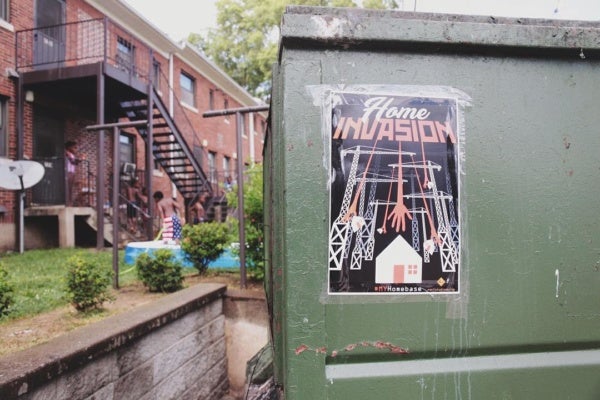
The Politics of Dis-belonging
Nashville has as complicated a racial history as any American city. The city proper’s two mainstays of black cultural life, Jefferson Street and what’s now called Chestnut Hill, were eviscerated by Interstate 40 in the 1960s, which hastened the process of disinvestment in these communities.
Bedoya is not so much a critic of creative placemaking as he is a revisionist of its practice. As former executive director of the Pima Arts Council in Tucson, Arizona, and current cultural affairs manager of Oakland, California, Bedoya is an adept navigator of the tension within institutions that fund creative placemaking. To Bedoya, discourse around creative placemaking is often tethered to the built environment, urban policy framework, and economic development. But there’s a fallacy here, because, as Bedoya writes, “before you have places of belonging, you must feel you belong.”
To understand this, city officials, urban planners, and artists must address social and racial injustices that will inevitably intersect with creative placemaking projects in communities. It opens a hatful of issues: Are local governments willing to admit that a city’s boom isn’t beneficial to everyone? Are they willing to acknowledge structural racism and inequality? Do artists have the skills required–or the right–to assert themselves on a neighborhood that is not their own? And what about those of us who are drawn to cities for their cultural life and seek cheap rent in neighborhoods where we don’t look like the people living there? When do “creative economy” measures become a branding mechanism to promote a sanitized progressivism that prioritizes money over people?
Intentions don’t always equal impact. “One needs to reflect upon U.S. History and its troubling legacy of ‘placemaking’ manifested in acts of displacement, removal, and containment,” Bedoya writes. That’s a tall–but not unfair–order for artists benefiting from creative placemaking grants.
But even with this knowledge, artists run into tricky territory: How can you give voice to people at the margins without telling their stories for them? How can you learn about the needs of a neighborhood without treating its people like they’re monolithic? And it gets more complicated if you have longstanding ties to the community, like Doughjoe in North Nashville.
“If you’re in it, you quickly see that it’s making a place for people who might not be you,” says Doughjoe. “How do you keep your place? How do you not assist in getting other people displaced when all you’re trying to do is have an inclusive place? It’s an interesting thing to maneuver.”
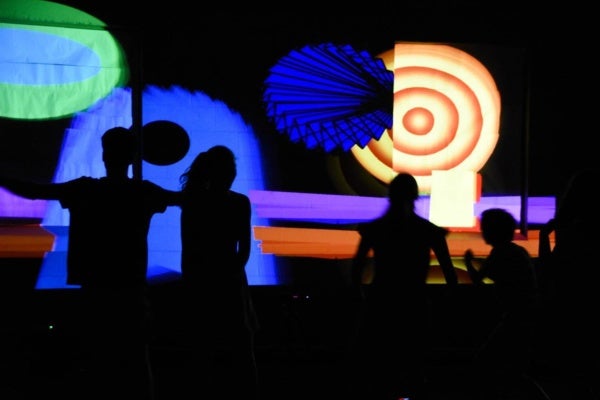
Pluralism on the Pike
Nolensville Pike runs southeast from the city’s center. It’s a brutally busy four-lane road with turning lanes that only make it more harrowing to cross on foot. Sidewalks appear and end at random; there are no bike lanes; bus stops are no-frills, often without even a bench; cars speed down the thoroughfare and then bottleneck and back-up along the interstate ramps.
It’s along this route that so many communities of New Americans make their home. You’ll find people from all over Central and South America, Kurdistan, Somalia, Sudan, Turkey, Ethiopia, Laos, and many more. The community center Casa Azafrán functions as a kind of gateway into this de facto international district. Through the nine nonprofits the center houses, recent immigrants and low-income earners can receive information about legal help, homeownership, and taxes; take ESL courses; and apply for naturalization, to name just a few services. The center was opened by Conexión Américas, a 15-year old institution that advocates for Latino immigrants and helps them integrate into their new community.
Here’s where the creative placemaking comes in. Conexión Américas partnered with Nashville Civic Design Center to conceive a public art project that began with listening–a whole lot of listening. The “Your Community, Your Priorities” workshops asked people visiting the center to drop a bean in the jar that described their most pressing concerns for the neighborhood. The options were complete streets; affordable housing; open green space; shop, eat, play locally; access to public transit; and improved transit service. Later, they hosted six artist-led Creative Labs where participants discussed assets in their communities and prioritized needed changes. Then, participants created what they’d like to see change in their neighborhood by sculpting with Play-Doh and pipe cleaners on laminated maps. Many ideas were practical, like pedestrian refuge circles and bridges, medians that act as midpoints in crossing five lane streets, and bus stop shelters. Others were impractical, like a farm and mountain hiking trail. But that’s all part of it. As residents imagine their best neighborhood, they insert themselves into the future of a city that may not be economically hospitable down the line.
Transportation and safety on the Pike figured heavily into discussions and mapping throughout the communities, so Conexión Américas took up that issue with projects that respond to the needs of residents and respect the cultural and visual aesthetics that already exist. In one, high school students from the corridor designed and built a bus shelter with input from MTA and Public Works, which in turn gave officials in these departments the opportunity to get to know the youth. In another, students in the Glencliff High School chapter of Escalera, an afterschool club that helps immigrant and refugee children navigate the path to college, interviewed longtime residents and recorded the oral history with sound engineering help from Nashville Public Library. In its third project, Conexión Américas hired artist Kristen Chapman Gibbons to set up booths in the neighborhood to collect stories about how people get around on the Pike.
But just 300 yards away from Casa Azafán, a massive development is in the works that will include 180 condos and 10,000 square feet of retail space. Core Development, the local infill developer who bought the five-acre plot of land, has already been building an 82-unit complex nearby called Alloy on Tech Hill; units there are being sold for between $158,000 and $350,000.
This begs the question: Can Nashville continue growing at this pace without erasing the cultural pluralism that makes it truly vibrant?
A New Plan
Metro Arts Commission just unveiled a Public Art Community Investment Plan that earmarks funding for neighborhood projects that foster civic connection and give voice to residents. It also plans to launch community-based art studios and residencies, fund temporary artworks, and coordinate with branches of local government to bring artists to decision-making tables.
If you read through the plan, you see that at nearly every stage of the next two years, Metro is training and mentoring artists so they can successfully move toward equity in their own practice and with community. Metro already began this work with Learning Labs, a workshop-based course geared toward teaching artists how to plan, launch, and execute public and neighborhood-based projects. Each artist in the Lab developed a project over the course of six months, and at the end of the period, Metro Arts chose 10 to fund. They range in subject matter and media: Johnson developed M-SPAR in the labs. Robbie Lynn Hunsinger’s interactive audiovisual project is a genius bit of responsive technology that merges the movements of participants with sound and animation. Xavier Payne created a billboard series for North Nashville’s Jefferson Street that addresses gentrification by recontextualizing the American Revolution’s “Don’t tread on me” flag that’s been co-opted by the Tea Party.
Another Learning Lab-funded artist is Woke3. Back in 2015, he used a Metro award of $4,000 to fund a mural project and art festival in a North Nashville storage yard, and the energy it generated spurred the development of Norf Collective. The group put on another event in the same spot a couple seasons later, and both drew people from all over the neighborhood and beyond. Norf hoped to continue to use the space as an arts refuge for more community programming, but placemaking met profit when the building manager rented it out to another team of curators who dubbed it Bridge Below Space, leaving Norf in the lurch. Meanwhile, the collective faced obstacles in other ways: getting clearance to do events at community centers and parks, for example.
“When the idea of McGruder came up,” says Doughjoe, “we were like, we can do it there. It’s very central.” They’ve hosted a community day and mural painting to bring people into the center and taught youth art workshops. They get studio space for free. Norf’s Learning Lab pairs community workshops with a poster campaign. Resembling movie posters titled Home Invasion, artist ArJae Thompson locates his community’s anxiety with simple images: homes, hands, and those hated cranes.
By and large, creative placemaking progress will be hard to measure, and it may be too late for some areas of town. It’s a long game, and only time will tell whether Metro’s efforts to buoy communities with art will in fact protect the interests of residents who called Nashville home long before the cranes went up.
“There’s trouble in qualifying something that’s not so tangible or not immediately seen as valuable…but is that a reason not to do anything?” says Doughjoe. “Or do you just fight the battle when that happens? Or do you try to preclude or retard that action? In large part, that is cultural placemaking for a community like this. It’s showing the history of North Nashville as predominantly black. That cannot be erased.”
This article was made possible by the National Endowment for the Arts.
